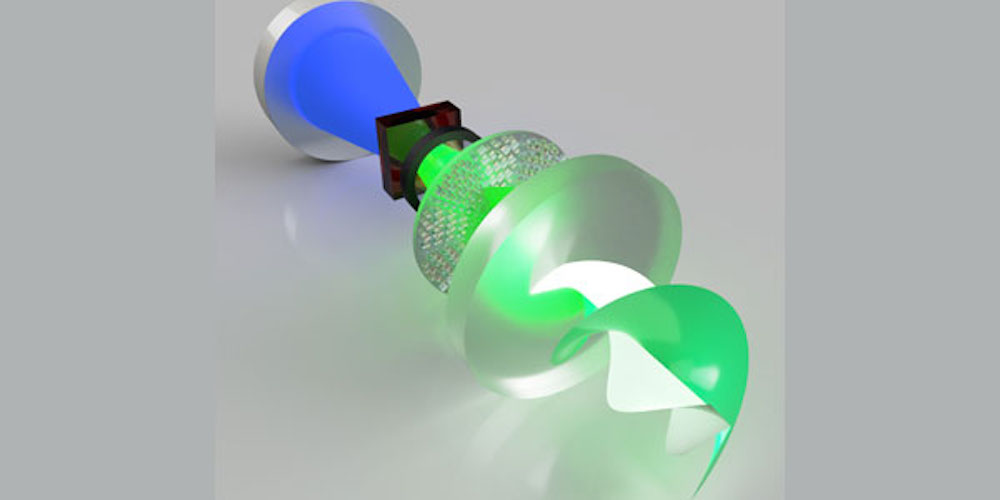
[Image above] An artistic impression of the metasurface laser to produce super-chiral light with orbital angular momentum up to 100. Credit: University of the Witwatersrand
It’s been a while since we last talked about metasurfaces.
A metasurface is a planar sheet material made of an artificial nanostructured interface with subwavelength thickness. Optics researchers have broadly investigated and implemented metasurfaces in electromagnetics applications over the past decade due to metasurfaces’ light weight, ease of fabrication, and unique abilities for blocking, absorbing, concentrating, dispersing, or guiding waves.
I became interested in metasurfaces when I came across research on a specific type of metasurface, a metalens. Metalenses focus light without causing chromatic aberrations and so could one day replace the need for multiple curved glass lenses of varying thickness in cameras and imaging devices—a day fast approaching now that mass production of metalenses is possible.
Besides metalenses, I’ve seen a wide variety of other metasurface research taking place, from new fabrication methods to metasurfaces that measure polarization or control the amplitude and phase of light.
Last week, I found a new study that showcased another ability of metasurfaces—the ability to control chirality of light.
Understanding chirality: Spin and orbital angular momentum of light
To appreciate the novelty of the new study, let’s take a moment to discuss chiral light.
Chirality is a property of asymmetry and describes an object that cannot be superposed on its mirror image.
“It is far from obvious that this has anything to do with the angular momentum of light, which owes its existence to rotational symmetries,” researchers explain in an open-access Philosophical Transactions of the Royal Society A article. “There is nevertheless a subtle connection between chirality and the angular momentum of light.”
Angular momentum refers to the quantity of rotation of an object. There are two well-established forms of rotation in light: spin angular momentum (SAM), which involves the light’s polarization; and orbital angular momentum (OAM), which involves the light’s wavefront shape.
In regard to SAM, light can be polarized in different geometries. When light is circularly or elliptically polarized, its orthogonally coupled electric and magnetic fields oscillate in a left- or right-handed helix (chiral) geometry. Likewise, a light with OAM typically exhibits a helical (chiral) wavefront shape. Thus, both SAM and OAM play a role in the chirality of light.
In recent years, a lot of research on tailoring SAM and OAM to control light chirality has occurred because chiral light is useful in various applications, including study of high-dimensional quantum states, enhanced imaging and microscopy resolution, and control of matter by optical trapping and tweezing.
But despite some impressive advances, “breaking the symmetry of the spin and orbital states for arbitrary angular momentum control of light at source has remained elusive,” the researchers of a new study write in their paper.
Achieving arbitrary angular momentum control:
Breaking OAM symmetry
The new study was done as a collaboration of the University of the Witwatersrand (Wits) and the Council for Scientific and Industrial Research in South Africa, Harvard University, National University of Singapore, Vrije Universiteit Brussel (Belgium), and Center for Nano Science and Technology of the Italian Institute of Technology.
In the paper, the authors explain that if researchers can achieve arbitrary angular momentum control of light, then they would be able “to produce any desired spin–orbital chiral state of light, including arbitrary, differing and non-symmetric OAM values coupled to user-defined polarizations.”
In essence, arbitrary control would greatly expand access to new light chirality states because researchers would be able to produce nonsymmetric OAM modes, compared to restrictions set by symmetric OAM modes. In particular, it would allow access to super-chiral light with high angular momentum—something known to be important in many fundamental and applied studies.
To achieve arbitrary angular momentum control of light, the researchers designed and fabricated a custom dielectric metasurface made of amorphous TiO2 nanoposts on a fused-silica substrate.
“Our metasurface … is designed to convert any two orthogonal polarization states of the incident light into helical modes with any arbitrary value of OAM, ℓ1 and ℓ2, and not just opposite values. This is possible by controlling the [Pancharatnam–Berry] phase, the overall phase and the form birefringence of each element,” they explain.
In other words, the metasurface gave the researchers full control over both SAM and OAM—allowing them to produce any desired chiral state of light.
In their study, the researchers used the metasurface on an infrared laser to gain control of its chirality. However, they explain the metasurface lends itself to many laser architectures.
“For instance, we could increase the gain volume and metasurface size to produce a bulk laser for high-power, or we could shrink the system down onto a chip using a monolithic metasurface design,” Andrew Forbes, senior author and professor at Wits, says in a Wits press release.
“Our work represents an important step towards merging the research in bulk lasers with that of on-chip devices,” he adds.
The paper, published in Nature Photonics, is “High-purity orbital angular momentum states from a visible metasurface laser” (DOI: 10.1038/s41566-020-0623-z).
